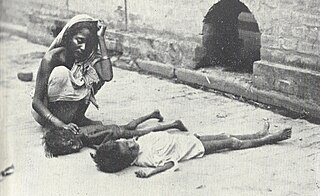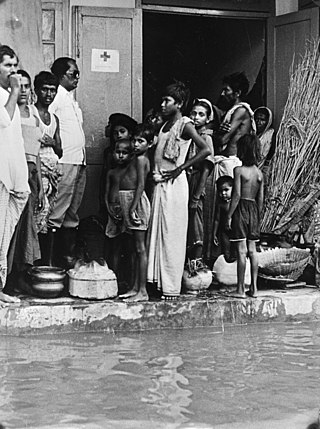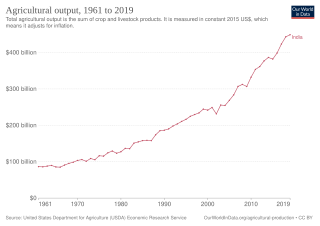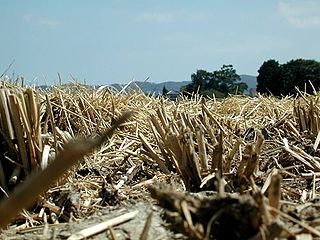The 2007 West Bengal food riots took place in West Bengal, India over shortage of food and widespread corruption in the public distribution system. The riots first happened in Burdwan, Bankura, and Birbhum districts but later spread to other districts. The riots started on 16 September 2007 in Radhamohanpur village in Bankura district.
Three villagers were shot dead and more than 300 villagers were injured in riots. At least three ration distributors committed suicide. The State Government suspended 113 dealers and served show cause notices to 37 food inspectors. A Supreme Court of India appointed committee has found wide-spread corruption to be the root cause of the riots.
India had a public distribution system that was used to distribute food grains to poor people at affordable prices fixed by the government. These food grains are distributed through Ration Shops, to card-holders. Many of these ration shop dealers were also Rice Mill owners, able to control the entire chain of supply. In 2007-08 a worldwide phenomenon of increasing food prices motivated some of the dealers to sell quality food grains in open market while inferior quality grain was distributed through the ration shops. At the same time, a move by the state government to exclude some of the families above poverty line from the PDS system. Faced with increasing food prices, this led to increasing discontent among the masses. [1]
In many places, the houses of local PDS dealers were set on fire and looted in many instances. The threat of violence and public humiliation also led to a few PDS dealers committing suicide. The riots originated from Bankura district in the latter half of the year, soon spreading across many other districts in the state. [2]
A report by the commission appointed by the Supreme Court of India found that wide spread corruption and diversion of superior quality food grains caused the riots. The report said studies conducted by the government had shown that 34.9% of rice and 86.6% of wheat meant for PDS got diverted, while 83% of wheat meant for below poverty line people and 60% of rice (the essential diet of the poorest of the BPL families) also got stolen. [1]

The Bengal famine of 1943 was a famine in the Bengal province of British India during World War II. An estimated 800,000–3.8 million people died, in the Bengal region, from starvation, malaria and other diseases aggravated by malnutrition, population displacement, unsanitary conditions, poor British wartime policies and lack of health care. Millions were impoverished as the crisis overwhelmed large segments of the economy and catastrophically disrupted the social fabric. Eventually, families disintegrated; men sold their small farms and left home to look for work or to join the British Indian Army, and women and children became homeless migrants, often travelling to Calcutta or other large cities in search of organised relief.

The Bangladesh famine of 1974 began in March 1974 and ended in about December of the same year. The famine is considered one of the worst in the 20th century; it was caused by government mismanagement, food grain smuggling to neighboring countries and flooding along the Brahmaputra River among other issues, resulting in high mortality. The government of Bangladesh estimated the number of deaths at 27,000 while according to experts, 1.5 million people must have died in total because of the famine.

The history of agriculture in India dates back to the Neolithic period. India ranks second worldwide in farm outputs. As per the Indian economic survey 2020 -21, agriculture employed more than 50% of the Indian workforce and contributed 20.2% to the country's GDP.

The Ministry of Consumer Affairs, Food and Public Distribution is a government ministry of India. The ministry is headed by a Cabinet rank minister.

World food prices increased dramatically in 2007 and the first and second quarter of 2008, creating a global crisis and causing political and economic instability and social unrest in both poor and developed nations. Although the media spotlight focused on the riots that ensued in the face of high prices, the ongoing crisis of food insecurity had been years in the making. Systemic causes for the worldwide increases in food prices continue to be the subject of debate. After peaking in the second quarter of 2008, prices fell dramatically during the late-2000s recession but increased during late 2009 and 2010, reaching new heights in 2011 and 2012 at a level slightly higher than the level reached in 2008. Over the next years, prices fell, reaching a low in March 2016 with the deflated Food and Agriculture Organization (FAO) food price index close to pre-crisis level of 2006.

The 2008 global rice crisis occurred between January and May 2008, the international trading price of rice jumped dramatically, increasing more than 300% in just four months. By December 2008, prices had decreased substantially, if not returned to previous levels, marking an end to the crisis.

The Ministry of Trade is the cabinet-level ministry of the Iraqi government responsible for regulating and facilitating trade activities in Iraq. It owns a conglomeration of state-owned enterprises and operates a nearly $6bn annual budget that provides a monthly public food distribution program for Iraqis. This conglomerate also manages the import of grain, seeds, and construction materials.

Below Poverty Line is a benchmark used by the government of India to indicate economic disadvantage and to identify individuals and households in need of government assistance and aid. It is determined using various parameters which vary from state to state and within states. The present criteria are based on a survey conducted in 2002. Going into a survey due for a decade, India's central government is undecided on criteria to identify families below poverty line.

The Public Distribution System (PDS) is a food security system that was established by the Government of India under the Ministry of Consumer Affairs, Food and Public Distribution to distribute food and non-food items to India's poor at subsidised rates. Major commodities distributed include staple food grains, such as wheat, rice, sugar and essential fuels like kerosene, through a network of fair price shops established in several states across the country. Food Corporation of India, a government-owned corporation, procures and maintains the PDS.

Abhijit Sen was an Indian economist who focused on studying rural development. Sen was appointed to the Planning Commission of India between 2004 and 2014 and held a number of policy making positions in India. Amongst his works included recommendations toward establishment of minimum support price for farm produce and a universal public distribution system. Sen was a recipient of the Padma Bhushan, India's third highest civilian honor, in 2010.

The Tamil Nadu Civil Supplies Corporation is governed by Government of Tamil Nadu was registered under the Companies Act 1956. It is responsible for providing food grains, commodities for the people under Public Distribution System through Ration shops. It also provides kerosene at very low cost. Some of the commodities are Rice, Wheat, Sugar, Cooking Oil, Rava etc.,
Uttar Pradesh food grain scam took place between years 2002 and 2010, in Uttar Pradesh state in India, wherein food grain worth ₹350 billion (US$4.0 billion), meant to be distributed amongst the poor, through Public Distribution System (PDS) and other welfare schemes like Antyodaya Anna Yojana (AAY), Jawahar Rozgar Yojana and Midday Meal Scheme for Below Poverty Line (BPL) card holders, was diverted to the open market. Some of it was traced to the Nepal and Bangladesh borders, as in 2010 security forces seized Rs 11.7 million worth of foodgrains like paddy and pulses being smuggled to Nepal, another Rs 6062,000 worth of grains were confiscated on the Indo-Bangladesh border.

The Kerala State Civil Supplies Corporation Limited, abbreviated as and known better by its brand name Supplyco, is a Government of Kerala-owned company headquartered at Kochi, India. It acts as the execution arm of the Department of Food and Civil Supplies of the Government of Kerala. Founded in 1974, the company serves the purpose of governmental intervention in the retail market to control prices of essential commodities.
Parivartan (Transformation) is a grass-roots activism organization based in the Sundar Nagari area of New Delhi, India. During the 2000s, Parivartan used Right to Information (RTI) to address citizens' grievances related to Public Distribution System (PDS), public works, social welfare schemes, income tax and electricity. By 2012, Parivartan was largely inactive, and its main leaders Arvind Kejriwal and Manish Sisodia had launched a political party - the Aam Aadmi Party.

The National Food Security Act 2013, also known as Right to Food Act, is an Indian Act of Parliament which aims to provide subsidized food grains to approximately two thirds of the country's 1.4 billion people. It was signed into law on 12 September 2013, retroactive to 5 July 2013.

Ration cards are an official document issued by state governments in India to households that are eligible to purchase subsidised food grain from the Public Distribution System under the National Food Security Act (NFSA). They also serve as a common form of identification for many Indians.

Following heavy rain in July and August 2017, the Indian state of West Bengal was affected by severe flooding. The floods were reported to have caused 50 deaths since 1 August and 8 deaths in the neighbouring state of Jharkhand.
Pradhan Mantri Garib Kalyan Anna Yojana is a food security welfare scheme announced by the Government of India on March 26 2020, during the COVID-19 pandemic in India. The program is operated by the Department of Food and Public Distribution under the Ministry of Consumer Affairs, Food and Public Distribution. But the nodal ministry is Ministry of Finance.The scale of this welfare scheme makes it the largest food security program in the world benefiting 81.35 crore in India.

During 2022 and 2023 there were food crises in several regions as indicated by rising food prices. In 2022, the world experienced significant food price inflation along with major food shortages in several regions. Sub-Saharan Africa, Iran, Sri Lanka, Sudan and Iraq were most affected. Prices of wheat, maize, oil seeds, bread, pasta, flour, cooking oil, sugar, egg, chickpea and meat increased. Many factors have contributed to the ongoing world food crisis. These include supply chain disruptions due to the COVID-19 pandemic, the 2021–2023 global energy crisis, the Russian invasion of Ukraine, and floods and heatwaves during 2021. Droughts were also a factor; in early 2022, some areas of Spain and Portugal lost 60–80% of their crops due to widespread drought.